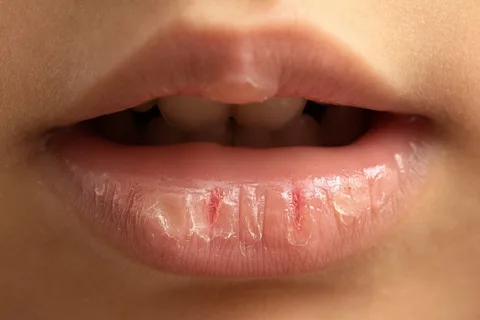Lesions of the mucous membrane due to hypovitaminosis
Machine translation
Original article is written in RU language (link to read it).
Vitamins are biologically active organic compounds that, in combination with proteins, lipids and carbohydrates, provide natural support for the functioning of the entire body.
There is primary hypovitaminosis, associated with an insufficient amount of vitamins in the food consumed by a person, with a monotonous diet or fasting. Secondary hypovitaminosis is observed with various lesions of the digestive tract associated with impaired absorption of nutrients, including vitamins; also in case of a disorder in the absorption of absorbed vitamins due to endocrine disorders and liver diseases.
Even more up-to-date information on diseases of the oral mucosa is available in the Periodontology Training section of our website.
Lack of vitamin A or retinol
The most important function of retinol is to control the differentiation of epithelial cells and regulate the process of keratinization, including the mucous membrane. The main physiological function of vitamin A is to ensure continuous renewal of epithelial tissue in the body.

Rice. 1. Healthy skin and red lip border.
Clinical manifestations of hypovitaminosis
All clinical symptoms are, to one degree or another, associated with morphological changes in the epithelial layer, namely:
- atrophy or excessive keratinization of the epithelium, causing a significant weakening of the protective mechanisms of the skin and mucous membranes;
- dry skin and mucous membranes, keratoses and hyperkeratoses, pathology of the sebaceous glands;
- decreased secretion of saliva and decreased salivation;
- in advanced cases, an inflammatory component may appear, accompanied by mucosal erosion and ulceration.
Lack of vitamin B1 or thiamine
The most important function of thiamine is to participate in the phosphorylation reaction necessary for the normal course of carbohydrate metabolism. Insufficient intake of vitamin B1 into the body does not allow carbohydrates to be burned completely, which leads to the accumulation of lactic and pyruvic acids, which cause disruption of the nervous and circulatory systems.

Rice. 2. Peeling skin and cracks in the corners of the mouth.
Thiamine is also involved in protein metabolism. Thiamine diphosphate is a thiamine derivative that is part of the cocarboxylase enzyme, which acts as a catalyst for the removal of CO2 from keto acids.
Clinical symptoms
- beriberi disease, accompanied by damage to the nervous and cardiovascular systems,
- paresthesia, neuroses, sleep disorders, suspiciousness, loss of strength, weight loss,
- lesions of the oral mucosa, typical of allergic reactions,
- proliferation of fungiform papillae,
- desquamative glossitis.
Vitamin B2 or riboflavin deficiency
Riboflavin is an integral component of most enzymes that ensure the normal course of redox reactions in the body. Riboflavin takes part in all types of metabolism.
Clinical symptoms form a triad
- dermatitis,
- cheilitis,
- glossitis.
Dermatitis
Localization: nasolabial triangle, eyelids, wings of the nose.
Appearance: hyperemia, peeling, crusts and cracks in the corners of the mouth, which, when torn off, leave an eroded surface. The red border is the first to peel; very quickly, against the background of peeling, numerous painful cracks appear, and bleeding occurs.

Rice. 3. Clinical manifestations of dermatitis.
Glossitis
Clinical manifestations on the tongue begin with redness, atrophy of the papillae gradually occurs, and sometimes they can disappear completely. As the process progresses, the back of the tongue acquires a bright red color, a smooth, shiny and dry surface.
Cheilitis
The patient complains of pain and burning on the lips, difficulty eating, pain while talking.
To make a diagnosis, biochemical blood and urine tests are performed.
Lack of vitamin PP or nicotinic acid
Pellagra is a disease that develops in a patient when there is insufficient intake of nicotinic acid into his body. Nicotinic acid is an integral component of metabolism, mainly carbohydrate.
Clinical symptoms characteristic of hypovitaminosis RR are as follows:
- loss of appetite,
- nausea, diarrhea,
- various lesions of the nervous system.
From the oral cavity
- the tongue swells significantly, increases in size,
- at the onset of the disease, hypertrophy of the papillae is observed,
- there is a thick layer of plaque on the back of the tongue,
- the plaque is gradually rejected, with the exposure of a shiny bright red surface in the areas of rejection, which is sharply painful under the influence of any irritants;
- as the pathological process progresses, the papillae of the tongue undergo complete atrophy, a shiny varnished tongue of bright red color, painful on palpation, is detected in the oral cavity;
- the rest of the oral mucosa is swollen, reddened, hypertrophied; a common symptom is the appearance of blisters, which quickly open to form painful erosions.
Lack of vitamin C or ascorbic acid
Scurvy is a disease that develops due to insufficient intake of ascorbic acid in the body or in case of impaired absorption of this vitamin.
Insufficient ascorbic acid content triggers the following pathological processes:
- reduction in the number of redox enzymes,
- carbohydrate metabolism disorder,
- protein metabolism disorder
- weakening of protective mechanisms (phagocytic activity decreases, antibody formation decreases significantly),
- the processes of synthesis of collagen fibers and the formation of connective tissue slow down, resulting in pathological permeability of tissues and blood vessels.
The appearance of ascorbic acid deficiency, in addition to the direct lack of vitamin in food, is associated with the following risk factors:
- increased physical activity,
- hypothermia,
- infectious diseases,
- emotional stress,
- digestive disorders.
Regarding disturbances in the functioning of the gastrointestinal tract in the pathogenesis of hypovitaminosis C, it is important to note that against the background of the absence of free hydrochloric acid in the stomach, vitamin C is destroyed more quickly, and in the case of inflammation of the intestinal mucosa, the absorption of ascorbic acid is impaired.
Clinical symptoms of hypovitaminosis C
- hemorrhagic syndrome associated with increased permeability of small vessels and capillaries is especially pronounced if, along with a lack of ascorbic acid, vitamin P hypovitaminosis appears,
- the addition of a secondary infection and associated pathological manifestations,
- malaise, fatigue, weakness, loss of appetite, weight loss, muscle pain,
- The accumulation of melanin in the skin causes dryness and flaking.

Rice. 4. Peeling, dry skin and red border of lips.
Clinical manifestations in the oral cavity
- petechial hemorrhages on the oral mucosa,
- when the mucous membrane is injured, extensive hemorrhages are formed,
- at the initial stage of the disease, swelling of the gingival papillae is characteristic, which acquire a bluish-red color, an increase in their size, increased bleeding,
- mobility, and in severe cases, tooth loss,
- against the background of the development of a secondary infectious process, ulcerative-necrotizing gingivitis develops,
- necrosis of the gingival margin, less often of the tonsils.
Vitamin B6 or pyridoxine deficiency
Vitamin B6 is an important component of amino acid and lipid metabolism and plays an important role in the prevention of atherosclerosis.
Clinical symptoms of pyridoxine hypovitaminosis
- damage to the nervous system, its central and peripheral parts,
- drowsiness, lethargy,
- high excitability,
- neurodermatitis, peripheral neuritis,
- glossalgia, stomalgia, glossitis,
- eczematous cheilitis,
- seborrheic dermatitis.
Lack of vitamin B12 or cyanocobalamin
Vitamin B12 ensures the maintenance of hematopoiesis and the formation of red blood cells; along with folic acid, it promotes the synthesis of hemoglobin.
Clinical symptoms of cyanocobalamin hypovitaminosis
- Addison-Birmer pernicious anemia,
- redness and erosion of the mucous membrane of the lower lip,
- dysfunction of peripheral nerves (paresthesia of the mucous membranes of various parts of the oral cavity, neuritis, neuralgia),
- burning, paresthesia of the tongue, redness of the tip and its lateral surfaces, addition of atrophy of the papillae.

Rice. 5. Cracks on the lips, one of the symptoms of hypovitaminosis.
Lack of vitamin E or tocopherol
Vitamin E is a natural antioxidant; it slows down lipid peroxidation and takes part in cellular metabolism and protein synthesis. Tocopherol ensures the strength of the walls of blood vessels and their normal permeability.
Clinical manifestations of hypovitaminosis E
- pathological permeability of small vessels,
- capillary fragility,
- fatty liver infiltration,
- degenerative lesions of nerve cells, myocardium, skeletal muscles.
Vitamin E in dentistry is used to treat periodontal and mucosal diseases and improve regeneration.
If you liked this article, on our website you will find a lot of useful information on various areas of dentistry.


